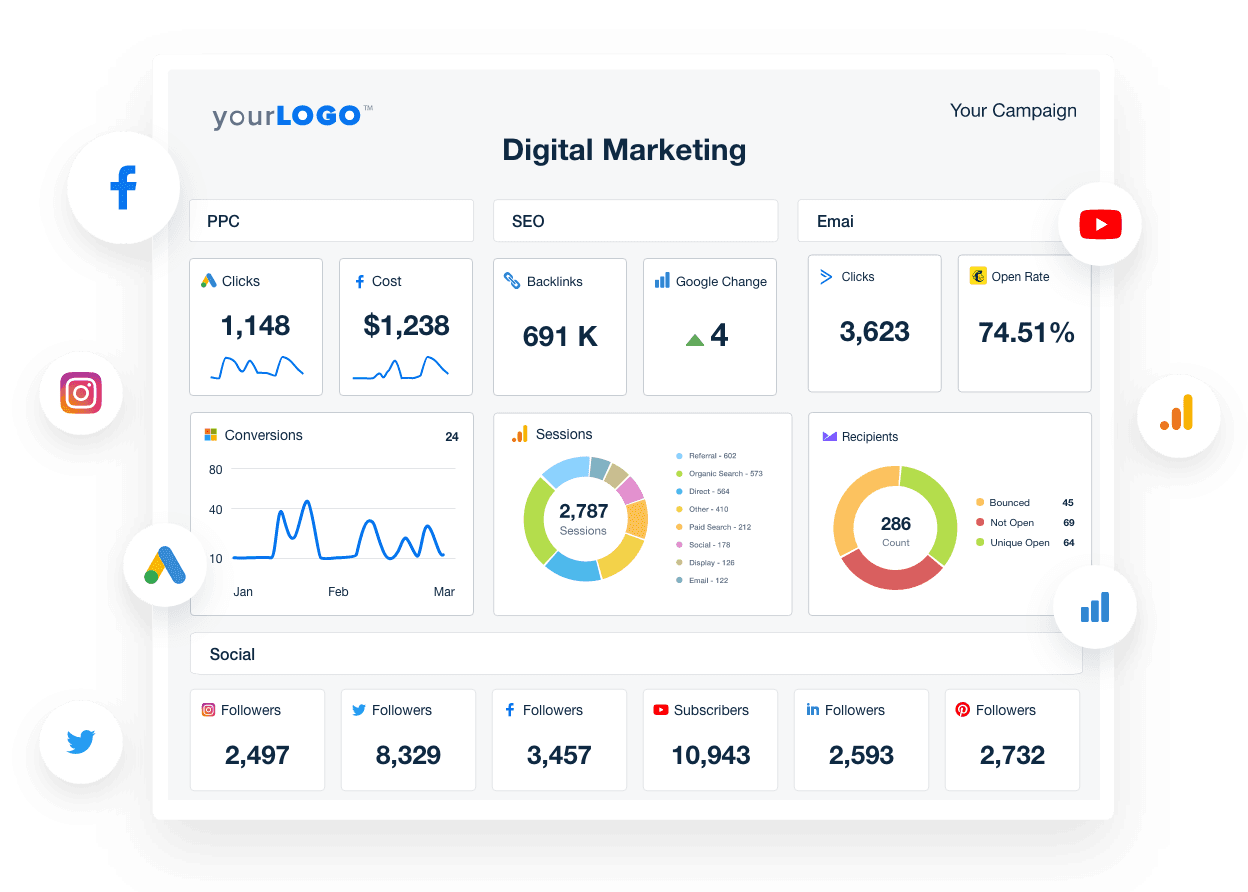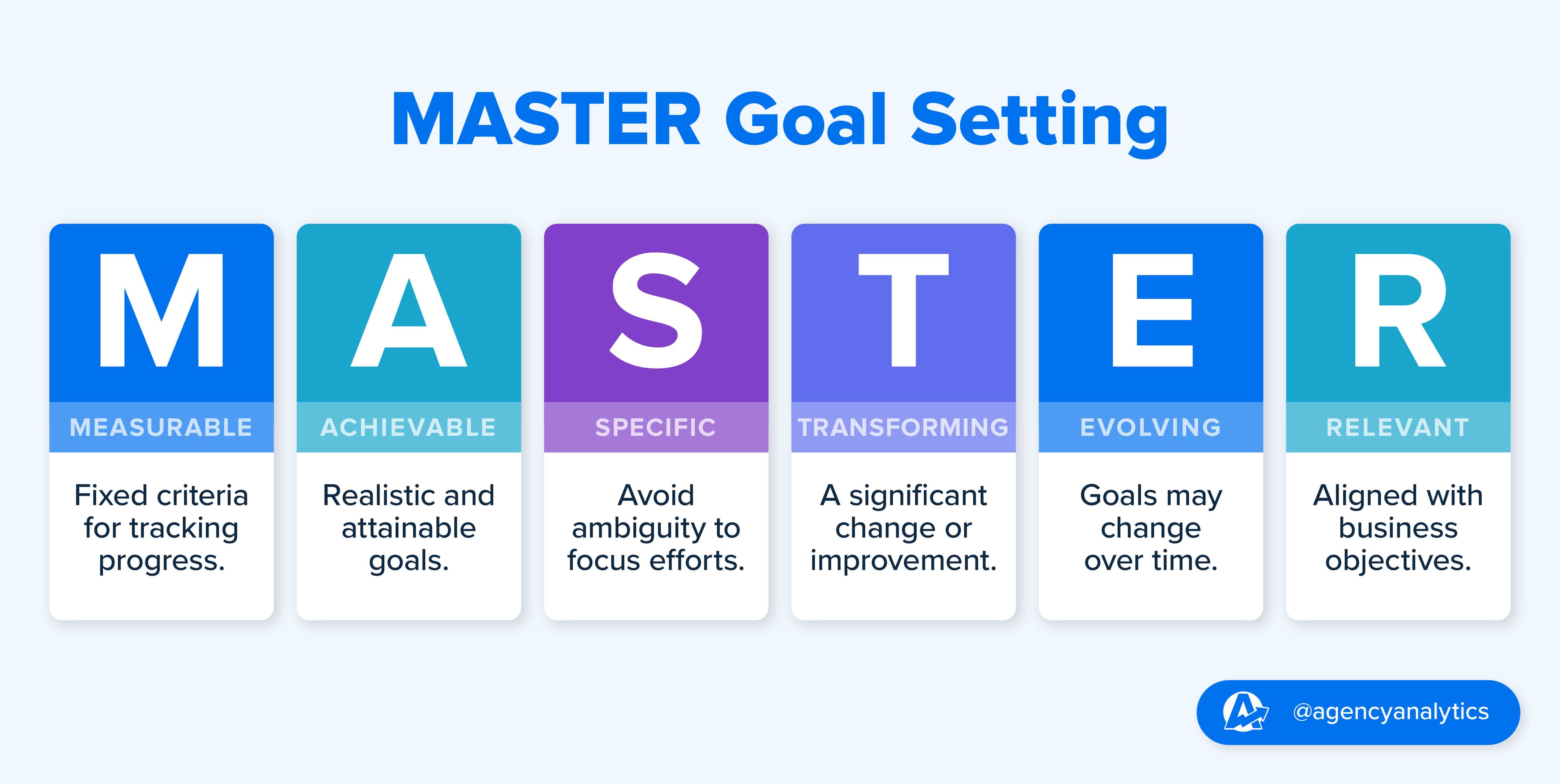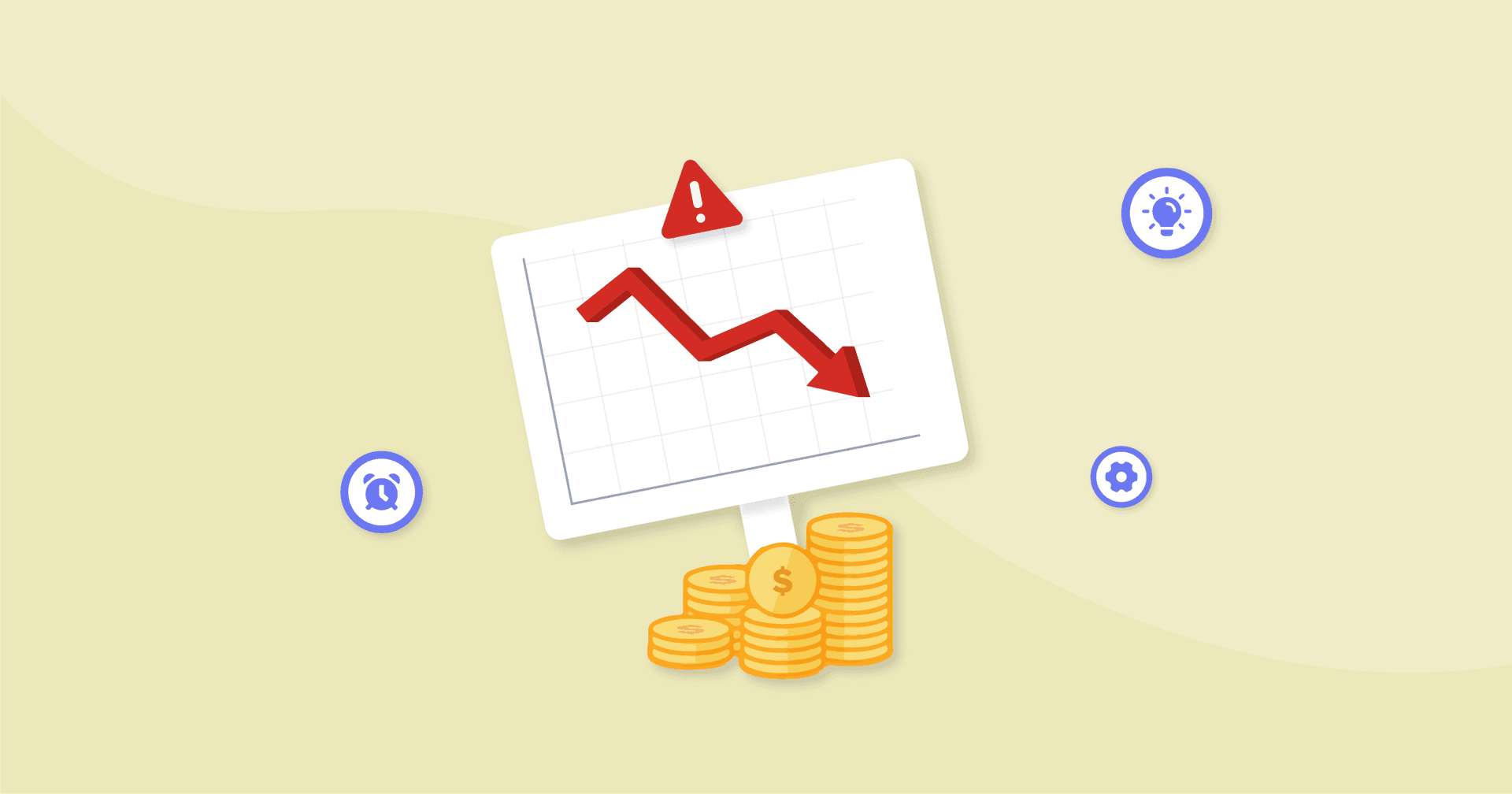Table of Contents
Table of Contents
- What Is Business Process Management?
- How To Effectively Manage Your Agency's Business Processes
- Why Use Business Process Management?
- The Potential Downside to Business Process Management
- Understanding the Business Process Management Lifecycle
- Choosing a Business Process Management Framework
- Applying Business Process Management to the Real World
- Best Practices for a Smooth BPM Implementation
- Creating an Efficient Agency
7,000+ agencies have ditched manual reports. You can too.
Free 14-Day TrialQUICK SUMMARY:
Business process management (BPM) optimizes agency efficiency by systematically improving business processes. Essential for long-term growth, BPM reduces bottlenecks and enhances workflow. This guide covers how to implement BPM to boost efficiency, manage resources, and improve client outcomes.
Business process management (BPM) isn’t just a buzzword, it’s an essential strategy to improve efficiency and ensure long-term growth, especially if you’re a results-driven marketing agency.
Research shows that only 1% of organizations have efficient business processes that allow them to leverage their full financial potential. Even though many businesses see the need for change, Gartner's BPM maturity model assessment found that 75% of organizations have yet to fully standardize and automate key processes through BPM.
While implementing business process management isn’t always straightforward–ask 20 people and you’ll likely get 20 different answers–it’s key to streamlining your agency’s processes, allowing employees to save time, avoid unnecessary errors, and create a smooth workflow.
Today we’re taking a deep dive into how business process management works and why your marketing agency can benefit. That way, you'll achieve better business outcomes and streamlined efficiency.
What Is Business Process Management?
To put it simply, BPM is a way of systematically improving business processes with the goal of optimizing agency efficiency and allowing executives to better manage information and employees.
But there’s more to it than that.
Anyone looking into this method will notice that definitions tend to vary between the different business process management professionals and industry players:
A COO may see BPM as a documentation framework that allows employees to provide clients end-to-end support and improve project management.
An IT lead would likely include the plethora of BPM software and suites in the definition, such as process modeling tools, workflow automation software, task assignment tech and much, much more.
A human resources exec would see it as an employee-centric framework focused on improving tasks that can’t be easily automated.
In the end, how you use business process management depends on your agency's long-term goals and what each business needs from the process.
Systems have been difficult to streamline. Because we don't do cookie-cutter strategies, distilling our processes into repeatable SOPs has been very challenging, and that's something I really wish I had either dedicated more time personally to, or hired the right person for, since day one.
Molly Lopez, Founder & CEO, Sparo
How To Effectively Manage Your Agency's Business Processes
Business process management (BPM) is an iterative process that depends on your unique goals. It’s a systematic method that allows agencies to examine each area of their workflow and optimize what’s not working. This could mean focusing on anything from cash flow and project management issues to lead generation metrics.
Let’s say, in this case, your agency is focused on lead generation and client retention, but currently has a manual, ineffective onboarding process for new clients. One way business process management could help is by allowing you to leverage CRM tools and marketing automation while empowering your team to create new documentation, leading to process improvement.
Essentially, you would have re-engineered your onboarding process to optimize your workflow.
Understanding the Process
Business process management (BPM) includes a variety of different strategies, such as:
Rapid Automation Solutions
This system will allow for immediate gains. For example, if your agency is looking to optimize its invoicing business processes, you may use a low-code BPM platform that integrates with your email and accounting services to create an automated workflow and minimize mistakes.
Complex Processes
This method focuses on optimizing the intricate, complex day-to-day tasks that are often connected to various other processes. By increasing efficiency through business process management, agencies can see improvements in many areas.

For example, if your agency needs to make changes to its campaign planning process, then part of your BPM strategy would include implementing automated reporting to reduce employee effort and efficiently track the progress of the campaign. AgencyAnalytics’ automated reporting features quickly create daily marketing reports, streamlining the process.
We have evolved our company to become the marketing firm our small business clients want. This sometimes means designing approaches and processes that aren't how we'd design them if we were just focused on our own profitability. We take feedback and shape our model to be exactly what our clients are looking for instead of what's best for us.
Lane Anderson, Founder & CEO, London Road Marketing
Outsourcing
This is a great way to increase operational efficiency for horizontal processes. Outsourcing usually works best on processes that aren't core to the business, but are still valuable, like IT or accounting tasks.
Why Use Business Process Management?
Without efficient business processes, it's easy to spend time and money on the wrong tasks. Business process management allows agencies to reduce costs, focus on high-revenue tasks and grow efficiently. Agencies that implement a BPM strategy:
Increase Adaptability and Visibility
Business process management (BPM) allows agencies to adapt quickly, empowering companies to change business strategy when necessary. Through transparent workflows, knowledge-sharing tools and improved project management, a BPM solution empowers faster decision making, allowing your team to see the effects of each option before choosing a path forward.
Better visibility means managers won't need to micromanage their employees, freeing them up for more important tasks.
Save Time and Money
By increasing efficiency in your business process, agencies ensure that billable time is spent where it matters most. The ability to focus on high-revenue activities leads to decreased costs and less of a chance your team will burn out before the next quarter. Another upside is a reduction of cycle times.
For example, let's say your agency's content approval process has become too time-consuming and includes a variety of departments. A business process framework would allow management to restructure the approval process using BPM software that streamlines real-time feedback.
Create a Better Client Experience
By optimizing your business process management systems and improving customer-retention metrics and key performance indicators, agencies are able to improve customer satisfaction and better meet client expectations. After all, if your team is spending less time on manual process management, they'll have more time to devote to your customers.
The more time we can save on admin tasks the more time we can spend doing what we’re best at! Every hour counts, and we want to ensure our clients receive maximum results.
Claire Aldridge, Digital Marketing Specialist, Victory Digital
The Potential Downside to Business Process Management
Depending on how your business process management (BPM) strategy is implemented, the system may come with some disadvantages, such as:
Less potential for creativity. If your business process management system is too strict, you could limit the ability to innovate and try new technologies. This is especially dangerous during times of rapid change. To avoid this, ensure your BPM system is flexible and supports innovation.
High start-up costs. While BPM tools are an important part of the business process, they can be costly. Research each solution before committing to make sure you're getting the best value for your dollar over the long term. That way, you'll avoid ending up with pricy or irrelevant business process management tools.
Over-reliance on technology. Business process management isn't just a tech solution. It involves crucial BPM methodology with many moving parts, and needs effective communication and coordination to succeed. While the tech is helpful, simply signing up for BPM cloud platforms won’t immediately improve business operations.
Marketing agencies need to speed up their innovation cycle and have systems/processes that are easy to innovate and scale.
Olu Ajanwachuku, CEO, GVATE LLC
Understanding the Business Process Management Lifecycle
Business process management (BPM) is, itself, a process. Successfully implementing this system requires more than just investing in the right BPM tools or creating new policies. Agencies implementing this strategy should aim for continuous improvement. There are typically five phases in the business process management lifecycle:
Phase 1: Design
In this stage, which is also called business process mapping, you'll work on designing new operational processes or improving current processes. This is when you would identify what your ideal solution looks like and determine who will be responsible for each stage of the workflow.
For example, let's say your workflow shows a lack of communication between the creative department, account management, and your clients. You may decide to change your business processes by using a software program that allows clients to easily provide feedback at each stage of a project.
Phase 2: Model
During this phase, you’ll define the real-life details of the process and figure out what the workflow will look like for your agency. You’ll also visually represent your workflow through flowcharts or process modeling software using real world data.
In our above example, you would now visually represent what the new workflow would look like for your clients, creative department, and account management. During this stage, all the practical details would be worked out, such as who will conduct training on the software, and the exact approvals that will need to take place at each step.
Phase 3: Execute
Once you've decided on new business process management (BPM) systems and business process automation, you'll be able to put it into action with a small test group.
In our example, this stage is when you’ll begin to implement your new software solution. You'll allow part of your team to test the new software to ensure it works well, and iron out any kinks in the workflow. From there, the solution can be expanded and adopted by everyone who needs it.
Phase 4: Monitor
Once you've implemented the solution, you'll monitor how it affects your team's workflow. This includes tracking key metrics to ensure profitability and growth. For example, you may track how the software affects client retention, revenue, and customer satisfaction.
Phase 5: Optimize
After monitoring your progress, you'll likely notice areas where your business process management solutions still need to be fine-tuned. During the optimization phase, you'll be able to make any necessary changes to ensure optimal efficiency. In our example, you could provide additional training on how to use the new software to ensure your team makes use of all of its features.
It's important to keep in mind that this process is a cycle that will repeat itself each time new business process changes are needed.
Choosing a Business Process Management Framework
Business process management typically falls into one of three frameworks:
Human-Centric
This category prioritizes the human workflow, focusing on business processes related to work done by humans that can't be completely replaced by technical solutions.
The best marketing and online positioning efforts require human intuition, feeling, and sentiment.
Bill Hipsher, President, Hurrdat
A business process in this category usually includes the need for approvals, individual tasks and human interaction.
System-Centric
Also called integration-centric, this framework encourages digital transformation and is focused on technical processes that work with many applications, such as SEO keyword tracking and analysis solutions.
While these processes will still include a human element–human workers will usually need to perform manual checks or reviews–it includes business process management software and process mining tools that increase your marketing agency's efficiency while streamlining the processes key to your agency's long-term growth.
Document-Centric
Document-centric BPM revolves around agreements, contracts, or any other documents important to your business process improvement.
Solutions in this category allow for documents to be more easily created, amended and signed. Tools used here include electronic signature software like DocuSign or Adobe Sign.
The varied functionality of the AgencyAnalytics reporting solution falls into all three categories:
The client and staff management features would be considered a human-centric BPM tool, as it allows managers to assign tasks to their teams while also easily communicating with clients.
Automated, white-labeled client dashboards are system-centric, allowing agencies to create a workflow that surfaces results in real-time and keeps clients updated 24/7, without having to manually pull the data.
Comprehensive client reports are document-centric, empowering agencies to pull data from more than 80 marketing integrations, and add annotations and notes for further context.

Applying Business Process Management to the Real World
Business process management is a highly effective system when used strategically, but it may seem overwhelmingly high level without real-world context.
Here’s how to use the framework in a variety of departments to identify bottlenecks, improve business processes and implement effective solutions.
Streamline Processes in HR
The Problem:
A disorganized, unstructured employee onboarding process leads to overly complicated, haphazard onboarding programs. Without a streamlined system and solid business process automation, employee retention and efficiency suffers. Recent research showed that proper onboarding increases employee retention rates by 82% and productivity rates by more than 70%.
Excessive documentation is another issue faced by many HR departments, especially in marketing, where NDAs and other legal requirements are common depending on your client. Your HR team is often forced to spend time on non-billable manual tasks instead of focusing on client work. This also includes timesheets and expense reports, which add unnecessary hours to an employee’s work day.
How BPM Helps:
Through business process management, human resource departments identify areas that need process improvement and implement BPM tools key to optimize these processes. When dealing with onboarding, BPM will:
Introduce process automation to eliminate repetitive tasks, such as sending welcome emails, verifying employee info and creating user accounts.
Standardize the onboarding process through the creation of checklists and organized workflows. This ensures all employees have the same onboarding experience.
Optimize communication between departments. Task assignment tools, for example, help HR easily collaborate with IT by quickly assigning tasks like computer set up. This reduces any bottlenecks in different departments.
For issues with excessive documentation, using business project management strategies will:
Help you implement timesheet tools that are quick and easy for employees to fill out, creating more efficient business processes.
Automate the expense report process
Make signing documentation easier through document signing tools
Identify which forms are necessary and which are too time-consuming, optimizing your process flow.
Reduce Accounts Receivable Bottlenecks
The Problem:
Particularly when an agency is scaling fast, it’s common for the invoicing and accounts receivable processes to become messy. With so many projects going out, and team members stretched to the max, it’s easy to lose track of which payments are outstanding as attention is drawn elsewhere.
But in an agency setting, cash flow is key to sustainable business growth. Streamlining payments and creating an efficient system for check-ins can mean the difference between smooth sailing and a sudden cash crisis.
How BPM Helps:
Through business process management, you can identify administrative bottlenecks and implement tools to take the burden off your accounting team, leading to process improvement. For example, your agency might consider changing your payment terms, or implementing a new accounting software to streamline invoice submissions.
From there, the workflow can be fleshed out to include checkpoints for account managers to connect with the client, and follow up if a payment does wind up late.
We have had to overhaul our billing policy and put stricter payment terms in place with clients because, unfortunately, we've been burned more than once by clients that we put our trust in to pay us and pay on time. Once legal gets involved, nobody wins, so it's better to get paid upfront for the work that you do or get a deposit to protect yourself from similar situations.
Molly Lopez, Founder & CEO, Sparo
Empower Your Creative Team
The Problem:
Creative teams often feel like they’re on a treadmill, running as fast as they can and getting nowhere. Some common problems faced by this department include:
Lack of communication with other departments. This is especially frustrating when approval is needed from account management or executive leadership.
Inability to identify and stop scope creep, which impacts both your team’s time and revenue potential.
Too many manual processes that should be automated through artificial intelligence-powered tools. Manually writing out a new brief for each article, for example, can be needlessly time-consuming.
How BPM Helps:
Through the business process management cycle, agencies are able to encourage digital transformation and automate processes using a number of software solutions, tools and workflows that support your creative team, freeing them up to focus on clients rather than inefficient systems. This includes:
Improving the communication process by using automation technologies and task management tools. These solutions allow teams to assign tasks both internally and to other departments, and quickly leave notes and approvals, eliminating any frustrating back-and-forth discussions.
Tracking scope creep and quickly letting clients know about this issue, leading to crucial business process improvement.
Creating standardized brief templates, which will expedite the brief-writing process.

Optimize Your Account Management Department
The Problem:
Without a streamlined system in place, your account management team may struggle to provide a top-tier customer experience. Common issues include:
Inefficient client information system. If your team has to manually enter each client’s info, they’re losing time that could be spent connecting with that client. It’s also easy to lose or misplace key details, which impacts client retention in the long-run.
Lack of client reporting. If your team is unable to organize key metrics and easily share them with clients, it may look like your campaigns aren’t succeeding, even when they are.
Chaotic client onboarding process, which leaves customers feeling disconnected and frustrated, making them less likely to sign a long-term contract.
How BPM Helps:
Business process management allows your team to set organizational systems in place, including client information management tools (think Salesforce or Hubspot CRM). These tools keep key info, like contact details, project notes and creative preferences, in one centralized, easily-accessible place, improving important business processes.
In terms of client reporting, AgencyAnalytics’ reporting solution allows agencies to efficiently perform business activity monitoring and share important metrics with clients. Create comprehensive white labeled client reports and dashboards in minutes, featuring data from more than 80 marketing platform integrations.
Business process management also streamlines client onboarding by creating a standardized process through BPM workflows and checklists. This ensures each client gets the attention they need in the early days.
Beyond streamlining manual processes, implementing a reporting platform like AgencyAnalytics provided several other benefits. Enhancing the overall efficiency of our reporting workflow helped us improve client satisfaction and build stronger relationships based on trust and transparency. Having a centralized reporting platform allowed us to gain deeper insights into client performance, empowering us to identify trends, uncover actionable opportunities, and make data-driven decisions to optimize our marketing strategies.
Joseph LeBlanc, Marketing Specialist, Studio Eighty-Eight
Best Practices for a Smooth BPM Implementation
Empowering process optimization is less of a step-by-step strategy and more of a continual improvement cycle with no real beginning or end. While business process management will look different to every agency, there are certain best practices that ensure an effective experience:
Know Your Goals
It’s important to make sure your business processes align with your agency’s long-term growth objectives.
Before examining which processes are working and which need to be adjusted, ensure you have a clear idea of what you want to achieve in the long-term. Consider using the MASTER framework to establish your agency’s goals first, before you dive into BPM.

Include Key Stakeholders in the Process
Once you’ve got a clear objective in mind, make sure all stakeholders are on the same page and involved in the process improvement strategy. This includes staff, people managers, and top leadership. This will help you avoid unnecessary push back on vital business process changes.
Documentation Is Key
Document everything. Without detailed documentation, it’s difficult to create standardized processes and ensure all teams understand how each process works. Documentation will also help you pinpoint what needs to change, create solid business rules, and enable continuous improvement.
Process Modeling Is Your Friend
This includes flowcharts and business process model and notation (BPMN) tools, which allow agencies to create clear process diagrams and documentation. This way, you’ll be able to quickly identify any bottlenecks in your existing processes.
Always Monitor Progress
As mentioned before, business process management is a cycle, not a straight line. Constantly monitoring your progress is crucial. This way, you’ll be able to use this information to catch any issues and tweak anything that’s not working, enabling continual process improvement.
Be Open to Tech and Automation
New technology, process mining, and automation solutions may seem complicated, but they’re often the heart of the BPM process. Robotic process automation like social media posting tools and artificial intelligence software free up employees to do more important client-focused tasks.
Make Continuous Improvement Part of Your Work Culture
Stagnancy doesn’t foster long-term growth. Ensure your work philosophy encourages agility and adaptability. This way, you’ll be able to pivot quickly if your business processes are no longer serving your goals.
Creating an Efficient Agency
Business process management is a powerful system for agencies looking to optimize their company’s resources and business rules.
The BPM cycle allows marketers to better understand their existing systems and identify any bottlenecks. Categories like pricing models, coaching or mentoring techniques, and agency burnout concerns can be addressed through this system, leading to substantial process improvement and risk management.
If your agency is eager to experiment with BPM, why not take the first step by signing up for a free 14-day trial with AgencyAnalytics? Streamline your client reporting process and start winning back billable hours today.

Written by
Rita Poliakov is an experienced content writer with a knack for storytelling. As a former journalist, she's a skilled researcher, interviewer, and grammar nerd.
Read more posts by Rita PoliakovSee how 7,000+ marketing agencies help clients win
Free 14-day trial. No credit card required.






